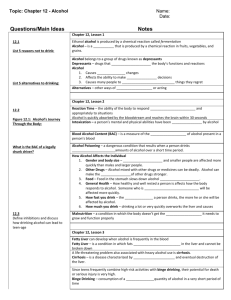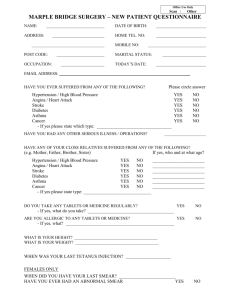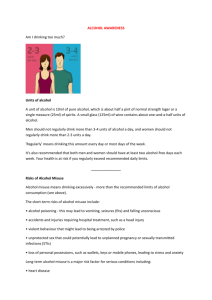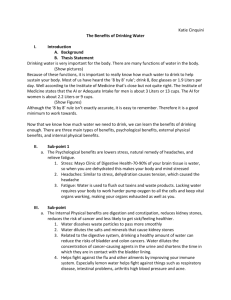alcohol expository
advertisement
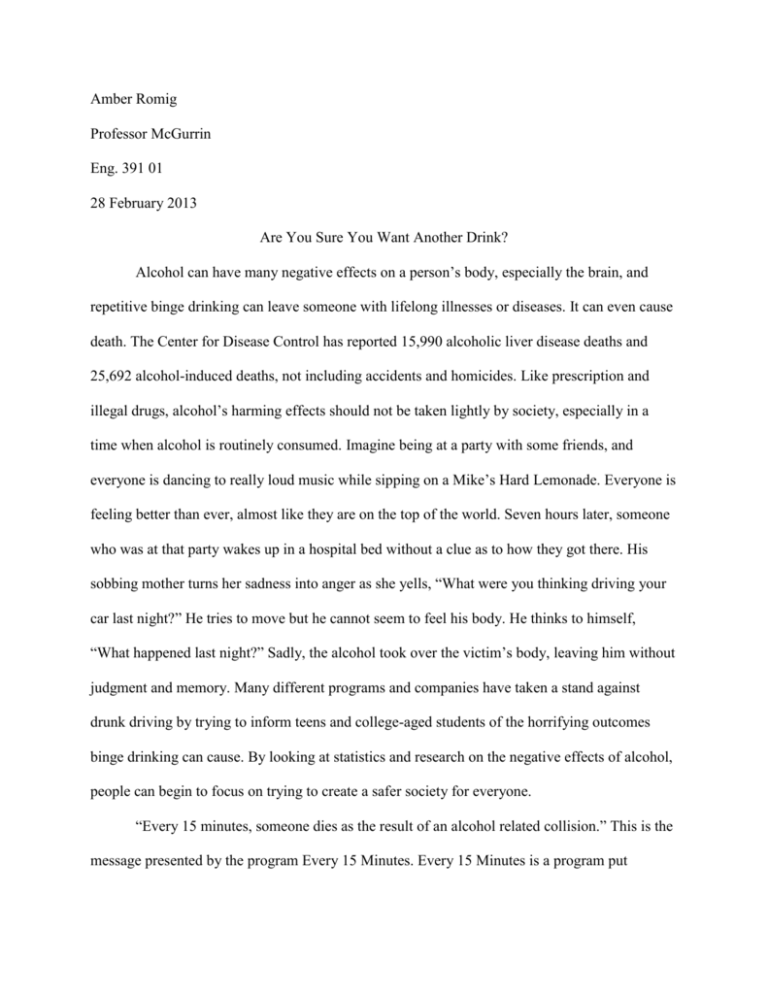
Amber Romig Professor McGurrin Eng. 391 01 28 February 2013 Are You Sure You Want Another Drink? Alcohol can have many negative effects on a person’s body, especially the brain, and repetitive binge drinking can leave someone with lifelong illnesses or diseases. It can even cause death. The Center for Disease Control has reported 15,990 alcoholic liver disease deaths and 25,692 alcohol-induced deaths, not including accidents and homicides. Like prescription and illegal drugs, alcohol’s harming effects should not be taken lightly by society, especially in a time when alcohol is routinely consumed. Imagine being at a party with some friends, and everyone is dancing to really loud music while sipping on a Mike’s Hard Lemonade. Everyone is feeling better than ever, almost like they are on the top of the world. Seven hours later, someone who was at that party wakes up in a hospital bed without a clue as to how they got there. His sobbing mother turns her sadness into anger as she yells, “What were you thinking driving your car last night?” He tries to move but he cannot seem to feel his body. He thinks to himself, “What happened last night?” Sadly, the alcohol took over the victim’s body, leaving him without judgment and memory. Many different programs and companies have taken a stand against drunk driving by trying to inform teens and college-aged students of the horrifying outcomes binge drinking can cause. By looking at statistics and research on the negative effects of alcohol, people can begin to focus on trying to create a safer society for everyone. “Every 15 minutes, someone dies as the result of an alcohol related collision.” This is the message presented by the program Every 15 Minutes. Every 15 Minutes is a program put together by fire departments, police departments, hospitals and courthouses. Presented at high schools, a select few students participate in a mock car accident caused by alcohol. Fellow juniors and seniors stand and watch their friends as one takes a sobriety test, another is put on a stretcher, and the final student is placed in a body bag after the parents identify her body. Participating students stay in a hotel overnight without any forms of communication as they listen to crash victims speak of their experiences. The next day, a ceremony is held on stage where two coffins rest representing the two crash victims. One by one, participants speak to their peers about their experiences in the program and discuss the dangers of drunk driving. Although the crash is not real, the feelings are intense as people cry and think of how lucky they are to get a “second chance.” Many people who have been drinking lose their sense of judgment and think they are okay to drive home or to somebody’s house. Not only are they putting their own lives at risk, but they are also putting other drivers and even pedestrians at risk. Underage drinking has become a huge issue in the American society. In 2009, 10.4 million people between the ages of 12 and 20 actually drank alcohol rather than just taking a sip. By the age of 18, “more than 70% of teens have had at least one drink.” Although teens may drink less than adults overall, when they do drink, they tend to drink more than adults which in some cases can be called binge drinking. Because of binge drinking, 5,000 people under the age of 21 die every year from “car crashes, homicides, suicides, alcohol poisoning, falls, burns, and drowning.” In 2008, over 190,000 teens had to be emitted to the emergency room for alcohol related injuries. Since drinking can cause impairment in judgments, teens can physically or sexually assault others or allow themselves to be assaulted by others. Also, the brain does not finish developing until a person is in his twenties, so binge drinking while young can cause problems in development. The National Survey on Drug Use and Health reports 87% of 12-17 year olds do not consume alcohol; however, the remaining 13% do consume alcohol which could cause future problems for not only them, but the people they are around as well. In the past 20 years, there has only been a 33% increase in parental influence in underage drinking according to the GfK Roper Youth Report. The lack of parental influence causes the 87% of young non drinkers to decline as children are not learning about the dangers of alcohol consumption. In college, many students experience freedom away from home where there are rules. Four out of five college students drink alcohol with half of college students participating in binge drinking. Every year, 1,825 students between 18 and 24 die from injuries caused by alcohol consumption. Alcohol consumption can also affect students who have not been drinking with over 690,000 of them being assaulted every year by someone under the influence and over 97,000 of students being sexually abused by those under the influence of alcohol. Students who drink heavily in college can even develop harmful illnesses from alcohol, and it has been reported that 1.2-1.5 percent of students have tried committing suicide due to drinking. Not only can alcohol cause physical and mental damage to college drinkers, but it can also cause students to miss class and do poorly on exams. 25 percent of students have had to face their academic consequences because of their drinking. The NIAAA’s Laboratory of Epidemiology and Biometry conducted a survey to find trends in drinking in American men and women in-------. 59.6% of women and 71.8% of men had at least one drink while the remaining individuals were abstinent from alcohol. Out of the people who drank, 28.8% of women and 43.1% drank over four alcoholic drinks within two hours at least once which is considered binge drinking. The liver is responsible for breaking down alcohol in the body. According to the University Counseling Center at Notre Dame, the liver can only metabolize 90 percent of the alcohol a person consumes, which means the other 10 percent leaves the body through breathing or by relieving oneself. Although the liver metabolizes a lot of the alcohol, it can only metabolize .015-.017 per hour, meaning the person will experience a hangover the next day depending on how much alcohol he consumed. While the intoxicated body is trying to lower the blood alcohol concentration, it is overloaded with glucose, causing an increase in insulin. The decrease in glucose causes a person to dehydrate, feel tired, shake, sweat, have blurry vision and feel dizzy. When people feel hung-over, they can experience vomiting due to the amount of toxins in their bodies, heartburn due to an inflamed esophagus, and diarrhea. The National Institute of Health goes into detail on several of the complications that may occur over time from drinking. Like the person who woke up in the hospital bed not knowing how he got there, some people can experience something called a blackout which means they have no recollection of the events that happened while they were intoxicated. 772 undergraduate students were surveyed on blackouts and surprisingly, 51 percent had experienced a blackout at some point in their life, 40 percent experienced a blackout the year before the survey and 9.4 percent experienced a blackout within two weeks before the survey. The students who had blacked out had trouble remembering their acts of vandalism, driving and unprotected sex while being under the influence. Liver disease can affect those who have had so much to drink that they damaged their livers which can also lead to a brain disorder called hepatic encephalopathy. The disorder can cause individuals to develop psychiatric symptoms such as depression and anxiety while also causing decreased coordination and personality changes. Alcohol releases two toxins called ammonia and manganese aid in the development of hepatic encephalopathy because of the damaged liver cells allowing these toxins in to the brain. Another disorder that can be caused by excessive alcohol consumption is WernickeKorsakoff. If someone develops Wernicke syndrome, symptoms will be short term, meaning they will not last forever, and they are not severe; however, it can cause confusion, eye movements from paralyzed nerves, and decreased coordination. Korsakoff psychosis, the more severe syndrome of Wernicke-Korsakoff, causes decreased learning ability, memory problems and difficulty walking. These victims experience retrograde amnesia as well as anterograde amnesia. An example is when the person tells a story about an experience they had earlier in life, but a few minutes later, the experience and conversation they just had are forgotten. Unfortunately, up to 90 percent of Wernicke victims develop the psychosis. Since the cerebellum is damaged, Wernicke victims can be injected with thiamine to improve the functions of the brain is the disease is caught early enough. When the disease develops into psychosis, little can be done to help the victim, and the only thing they can rely on is the support from their family. All in all, if alcoholism is a problem for someone, they could potentially be ending their life sooner than they planned. Alcohol should not be banned, but rather monitored. A way to do this would be to make alcohol bottles smaller so people do not have the option of drinking a large bottle. Larger bottles can be dangerous because if someone gets upset they may drink alcohol to make themselves feel better or to numb the pain. As stated before, too much alcohol can cause liver problems and other illnesses for the drinker. Since alcohol is expensive, people will most likely not feel the need to spend all of their money on smaller bottles of alcohol. This could work well for college students because most college students do not have a lot of money since most of it is going towards tuitions, books, and food. Students may be able to focus more on school rather than worrying about the next party. Instead of having parties every night, maybe students could shift into celebrating a couple times a semester for the end of exams so they can still excel in their studies, but have fun too. If smaller bottles are not an option, perhaps the prices could be raised or the taxes could be raised. As many people do not enjoy taxes, the government could say that the tax money is being used to create better and safer roads. Also, to decrease the amount of car accidents, the police should monitor areas like bars where people are drinking. They could possibly even conduct breathalyzer tests before people leave the bar, making sure everyone is okay to drive, and if they are not, police can either escort them or find a designated driver. Furthermore, many teens have parties at their homes so it may be a good idea for policemen to do a couple runs through neighborhoods at night to ensure everything is peaceful and no one is in danger. “Every 15 minutes, someone dies as the result of an alcohol related collision.” What will it take to increase the time?
